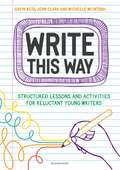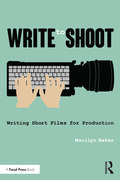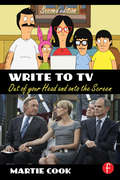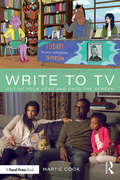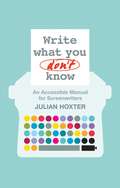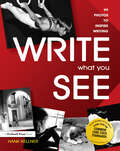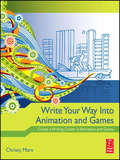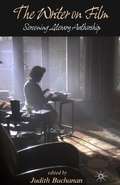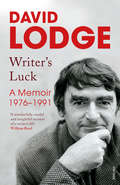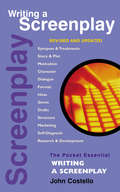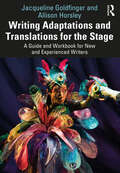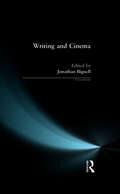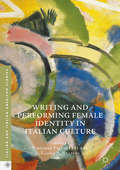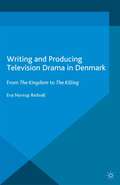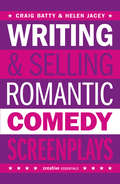- Table View
- List View
Write This Way: Structured lessons and activities for reluctant young writers
by Dr. Gavin Reid Jenn Clark Michelle McIntoshMany children avoid writing for a number of reasons – perhaps they find it tedious or frustrating, or perhaps they have dyslexia or dysgraphia. This structured programme of writing activities and lessons makes writing engaging and accessible for reluctant writers, by encouraging primary teachers and learners to work together to develop children's writing skills.The book covers all aspects of primary school writing, including grammar, sentence development, punctuation, paragraph writing and planning. It also shows teachers how to develop self-sufficiency skills in writing and encourage learner independence. Each section in the book builds on previous skills learned, from word level up to creative writing skills, providing pupils with a complete range of writing tools. The ready-to-use resources for each topic - including mini lessons, discovery tools and activities - offer extensions and adaptations to suit all pupil needs, including fun ideas for multisensory learning, group interventions or to keep pupils learning outside of the classroom.For school staff working with children who find writing challenging, this practical toolkit provides a range of activities based on solid research and hands-on experience that can be incorporated straight into lessons and teaching practices.
Write This Way: Structured lessons and activities for reluctant young writers
by Dr. Gavin Reid Jenn Clark Michelle McIntoshMany children avoid writing for a number of reasons – perhaps they find it tedious or frustrating, or perhaps they have dyslexia or dysgraphia. This structured programme of writing activities and lessons makes writing engaging and accessible for reluctant writers, by encouraging primary teachers and learners to work together to develop children's writing skills.The book covers all aspects of primary school writing, including grammar, sentence development, punctuation, paragraph writing and planning. It also shows teachers how to develop self-sufficiency skills in writing and encourage learner independence. Each section in the book builds on previous skills learned, from word level up to creative writing skills, providing pupils with a complete range of writing tools. The ready-to-use resources for each topic - including mini lessons, discovery tools and activities - offer extensions and adaptations to suit all pupil needs, including fun ideas for multisensory learning, group interventions or to keep pupils learning outside of the classroom.For school staff working with children who find writing challenging, this practical toolkit provides a range of activities based on solid research and hands-on experience that can be incorporated straight into lessons and teaching practices.
Write to Shoot: Writing Short Films for Production
by Marilyn BekerWrite to Shoot teaches budding screenwriters and screenwriting filmmakers how to write a short script with production in mind. Beker instructs them how to showcase their strengths, tailor projects to shoestring budgets, resources, and practical production parameters without sacrificing the quality and punch of their screenplays, whether they're creating a sizzle short for an unproduced feature script, an independent creative work, or a soapbox to promote a cause. Write to Shoot: Writing Short Films for Production is a must-have guide for anyone who wants to be sure there will be no surprises on set that come from a script that's not ready for production.
Write to Shoot: Writing Short Films for Production
by Marilyn BekerWrite to Shoot teaches budding screenwriters and screenwriting filmmakers how to write a short script with production in mind. Beker instructs them how to showcase their strengths, tailor projects to shoestring budgets, resources, and practical production parameters without sacrificing the quality and punch of their screenplays, whether they're creating a sizzle short for an unproduced feature script, an independent creative work, or a soapbox to promote a cause. Write to Shoot: Writing Short Films for Production is a must-have guide for anyone who wants to be sure there will be no surprises on set that come from a script that's not ready for production.
Write to TV: Out of Your Head and onto the Screen
by Martie CookLearn to craft smart, original stories and scripts for a variety of television formats and genres, including comedy, drama, pilots, animation, made-for-TV movies, late night, and reality television. Hear directly from studio and network executives, agents, and managers on what they’re looking for in new writers and how to avoid common pitfalls. Gain access to sample outlines, script pages, checklists, and countless other invaluable resources that will help you break into the industry and put you on the path to immediate success. In Write to TV, Second Edition industry veteran Martie Cook offers practical advice on writing innovative television scripts that will allow you to finally get that big idea out of your head and onto the screen. This new edition has been updated to include: Tips and techniques from industry vets Jay Leno, Norman Lear, Paul Haggis, David Magee, Susan Rovner, Tal Rabinowitz, Jonathan Littman, Peter Jankowski, Steve Stark, and Doug Herzog that you can immediately apply to your own projects Expanded coverage of writing pilots, pitching, writing webisodes, writing for tweens, writing for late night, and rewriting Useful advice for navigating the confusing television hierarchy, including how to network, get an agent, land that first writing job, and even "do lunch" 25 new interviews with writers and producers of hit shows such as New Girl, Parks and Recreation, The Blacklist, Curb Your Enthusiasm, CSI, The Tonight Show Starring Jimmy Fallon, and many more An all new companion website (www.writetotv.com) featuring blog updates, industry trends, a Q&A discussion forum with the author, and many other resources
Write to TV: Out of Your Head and onto the Screen
by Martie CookLearn to craft smart, original stories and scripts for a variety of television formats and genres, including comedy, drama, pilots, animation, made-for-TV movies, late night, and reality television. Hear directly from studio and network executives, agents, and managers on what they’re looking for in new writers and how to avoid common pitfalls. Gain access to sample outlines, script pages, checklists, and countless other invaluable resources that will help you break into the industry and put you on the path to immediate success. In Write to TV, Second Edition industry veteran Martie Cook offers practical advice on writing innovative television scripts that will allow you to finally get that big idea out of your head and onto the screen. This new edition has been updated to include: Tips and techniques from industry vets Jay Leno, Norman Lear, Paul Haggis, David Magee, Susan Rovner, Tal Rabinowitz, Jonathan Littman, Peter Jankowski, Steve Stark, and Doug Herzog that you can immediately apply to your own projects Expanded coverage of writing pilots, pitching, writing webisodes, writing for tweens, writing for late night, and rewriting Useful advice for navigating the confusing television hierarchy, including how to network, get an agent, land that first writing job, and even "do lunch" 25 new interviews with writers and producers of hit shows such as New Girl, Parks and Recreation, The Blacklist, Curb Your Enthusiasm, CSI, The Tonight Show Starring Jimmy Fallon, and many more An all new companion website (www.writetotv.com) featuring blog updates, industry trends, a Q&A discussion forum with the author, and many other resources
Write to TV: Out of Your Head and onto the Screen
by Martie CookIn Write to TV (third edition) industry veteran Martie Cook offers practical advice on writing innovative television scripts that will allow you to finally get that big idea out of your head and onto the screen. With this book you’ll learn to craft smart, original stories and scripts for a variety of television formats and genres, including comedy, drama, pilots, web series, and subscription video on demand. This new edition has been updated with expanded coverage on writing for global audiences, content creation for streaming services such as Netflix, Amazon and Hulu, as well as writing the web series, podcasts and utilizing free platforms such as YouTube. It also features new chapters on writing for niche markets; breaking into the writers’ room; creating binge-worthy series and how to accompany pilot scripts with a series pitch document. Plus, expanded information on creating complex and compelling characters including writing anti-heroes and strong female protagonists and much, much more. Including information directly from studio and network executives, agents, and managers on what they’re looking for in new writers and how to avoid common pitfalls, advice from successful creators and showrunners on creating original content that sells, and tips from new writers on how to get into a writers room and stay there. This book contains information from more than 20 new interviews, access to sample outlines, script pages, checklists, and countless other invaluable resources, and is the ideal book for anyone who wants to break into the TV writing industry.
Write to TV: Out of Your Head and onto the Screen
by Martie CookIn Write to TV (third edition) industry veteran Martie Cook offers practical advice on writing innovative television scripts that will allow you to finally get that big idea out of your head and onto the screen. With this book you’ll learn to craft smart, original stories and scripts for a variety of television formats and genres, including comedy, drama, pilots, web series, and subscription video on demand. This new edition has been updated with expanded coverage on writing for global audiences, content creation for streaming services such as Netflix, Amazon and Hulu, as well as writing the web series, podcasts and utilizing free platforms such as YouTube. It also features new chapters on writing for niche markets; breaking into the writers’ room; creating binge-worthy series and how to accompany pilot scripts with a series pitch document. Plus, expanded information on creating complex and compelling characters including writing anti-heroes and strong female protagonists and much, much more. Including information directly from studio and network executives, agents, and managers on what they’re looking for in new writers and how to avoid common pitfalls, advice from successful creators and showrunners on creating original content that sells, and tips from new writers on how to get into a writers room and stay there. This book contains information from more than 20 new interviews, access to sample outlines, script pages, checklists, and countless other invaluable resources, and is the ideal book for anyone who wants to break into the TV writing industry.
Write What You Don't Know: An Accessible Manual for Screenwriters
by Julian HoxterWrite What You Don't Know is a friendly manual for aspiring screenwriters. It encourages you to move beyond your comfort zones in search of stories. We all write what we know - how could we not? Writing what you don't know and doing it in an informed and imaginative way is what makes the process worthwhile. Hoxter draws on his wealth of experience teaching young film students to offer help with every aspect of the writing process, including how we come up with ideas in the first place. Light hearted and full of insight into the roundabout way film students approach their scripts, it also discusses the important issues like the difference between stories and plots and what your characters should be doing in the middle of act two. Write What You Don't Know contains examples and case studies from a wide range of movies, both mainstream and alternative such as The Virgin Spring, Die Hard, The Ipcress File, For The Birds, (500) Days of Summer, Juno, Up In The Air, Knocked Up and Brick.
Write What You Don't Know: An Accessible Manual for Screenwriters
by Julian HoxterWrite What You Don't Know is a friendly manual for aspiring screenwriters. It encourages you to move beyond your comfort zones in search of stories. We all write what we know - how could we not? Writing what you don't know and doing it in an informed and imaginative way is what makes the process worthwhile. Hoxter draws on his wealth of experience teaching young film students to offer help with every aspect of the writing process, including how we come up with ideas in the first place. Light hearted and full of insight into the roundabout way film students approach their scripts, it also discusses the important issues like the difference between stories and plots and what your characters should be doing in the middle of act two. Write What You Don't Know contains examples and case studies from a wide range of movies, both mainstream and alternative such as The Virgin Spring, Die Hard, The Ipcress File, For The Birds, (500) Days of Summer, Juno, Up In The Air, Knocked Up and Brick.
Write What You See: 99 Photos to Inspire Writing (Grades 7-12)
by Hank KellnerMotivate your students with the wide variety of photographs and writing prompts in this delightful book by award-winning photographer and former English teacher Hank Kellner.The varied prompts include key words, questions to consider, ideas for writing, possible opening lines, suggestions for research, and more. The book even comes with a CD so that you have the option of displaying the activities with an overhead projector.Write What You See contains a wealth of ideas for writing from the author as well as from real teachers across the country who have successfully used photography in the teaching of writing.Grades 7-12
Write What You See: 99 Photos to Inspire Writing (Grades 7-12)
by Hank KellnerMotivate your students with the wide variety of photographs and writing prompts in this delightful book by award-winning photographer and former English teacher Hank Kellner.The varied prompts include key words, questions to consider, ideas for writing, possible opening lines, suggestions for research, and more. The book even comes with a CD so that you have the option of displaying the activities with an overhead projector.Write What You See contains a wealth of ideas for writing from the author as well as from real teachers across the country who have successfully used photography in the teaching of writing.Grades 7-12
Write Your Way into Animation and Games: Create a Writing Career in Animation and Games
by Christy MarxLaunch your career in writing for video games or animation with the best tips, tricks, and tutorials from the Focal press catalog--all at your fingertips. Let our award-winning writers and game developers show you how to generate ideas and create compelling storylines, concepts, and narratives for your next project. Write Your Way Into Animation and Games provides invaluable information on getting into the game and animation industries. You will benefit from decades of insider experience about the fields of animation and games, with an emphasis on what you really need to know to start working as a writer. Navigate the business aspects, gain unique skills, and develop the craft of writing specifically for aniamtion and games. Learn from the cream of the crop who have shared their knowledge and experience in these key Focal Press guides: Digital Storytelling, Second Edition by Carolyn Handler Miller Animation Writing and Development by Jean Ann Wright Writing for Animation, Comics, and Games by Christy Marx Story and Simulations for Serious Games by Nick Iuppa and Terry Borst Writing for Multimedia and the Web, Third Edition by Timothy Garrand
Write Your Way into Animation and Games: Create a Writing Career in Animation and Games
by Christy MarxLaunch your career in writing for video games or animation with the best tips, tricks, and tutorials from the Focal press catalog--all at your fingertips. Let our award-winning writers and game developers show you how to generate ideas and create compelling storylines, concepts, and narratives for your next project. Write Your Way Into Animation and Games provides invaluable information on getting into the game and animation industries. You will benefit from decades of insider experience about the fields of animation and games, with an emphasis on what you really need to know to start working as a writer. Navigate the business aspects, gain unique skills, and develop the craft of writing specifically for aniamtion and games. Learn from the cream of the crop who have shared their knowledge and experience in these key Focal Press guides: Digital Storytelling, Second Edition by Carolyn Handler Miller Animation Writing and Development by Jean Ann Wright Writing for Animation, Comics, and Games by Christy Marx Story and Simulations for Serious Games by Nick Iuppa and Terry Borst Writing for Multimedia and the Web, Third Edition by Timothy Garrand
The Writer on Film: Screening Literary Authorship
by Judith BuchananExamining films about writers and acts of writing, The Writer on Film brilliantly refreshes some of the well-worn 'adaptation' debates by inviting film and literature to engage with each other trenchantly and anew – through acts of explicit configuration not adaptation.
Writer's Luck: A Memoir: 1976-1991
by David LodgeDavid Lodge’s frank and illuminating memoir about the years where he found great success as a novelist and critic.Luck plays an important part in the careers of writers. In this book David Lodge explores how his work was inspired and affected by unpredictable events in his life. In 1976 Lodge was pursuing a ‘twin-track career’ as novelist and academic. As a literary critic, he made serious contributions to the subject, before carnivalising it in his comic-satiric novel Small World. The balancing act between his two professions was increasingly difficult to maintain, and he became a full-time writer just before he published his bestselling novel Nice Work. Both books were shortlisted for the Booker Prize, in which he was later involved as Chairman of the judges.Readers of Lodge’s novels will be fascinated by the insights this book gives – not only into his professional career but also more personal experience. The main focus, however, is on writing as a vocation. Anyone who is interested in learning about the creative process, about the dual nature of the novel as both work of art and commodity, will find Writer’s Luck a candid and entertaining guide.
Writing a Screenplay (Pocket Essentials Ser.)
by John CostelloThe recent explosion of unsolicited material written for the world's greatest, sexiest entertainment medium has largely produced a mountain of wasted paper. Truth is, the many who write from scratch, no matter how talented, have more chance of winning the lottery than creating an excellent script. The few who achieve success do so because they have shed the blood, sweat and tears necessary to master the elaborate art and craft of Screenwriting. This book explodes the myth that a screenplay is the easiest literary form to master, navigates a relatively painless path through the Screenwriting labyrinth, and offers an easy to digest step-by-step guide to writing a script from inception to completion. What's in it? The main areas covered are: Motivation; Research & Development; Genre; Idea; Story & Plot; Audience; Character; Action & Setting; Structure; Format; Dialogue; Synopses & Treatments; Drafts; Marketing & The Industry. There's also a glossary of commonly used jargon to further demystify the process.
Writing Adaptations and Translations for the Stage: A Guide and Workbook for New and Experienced Writers
by Jacqueline Goldfinger Allison HorsleyWriting Adaptations and Translations for the Stage is a practical guide for writing adapted works for theatrical performance.Broadway translator and dramaturg Allison Horsley and award-winning playwright and educator Jacqueline Goldfinger take readers step-by-step through the brainstorming, writing, revision, and performance processes for translations and adaptations. The book includes lectures, case studies, writing exercises, and advice from top theater professionals on the process of creating, pitching, and producing adaptations and translations, covering a wide range of topics such as jukebox musicals, Shakespeare adaptations, plays from novels, theater for young adults, and theater in translation and using Indigenous language. Artists who share their wisdom in this book include: Des McAnuff (Tony Award), Emily Mann (Tony Award), Dominique Morisseau (Broadway Adaptor, Tony Award nominee, MacArthur Genius Fellow), Lisa Peterson (Obie Award, Lortel Award), Sarah Ruhl (Broadway Playwright, Tony Award nominee, Pulitzer Prize finalist, MacArthur Genius Fellow), and Tina Satter (Broadway Director, Obie Award, Guggenheim Fellowship). The book also features interviews with artists working both in the US and internationally, as well as guest columns from artists who work in less traditional adaptive forms including cabaret, burlesque, opera, community-engaged process, and commercial theater.Writing Adaptations and Translations for the Stage is an essential resource for students and instructors of Dramatic Writing, Playwriting, and Creative Writing courses and for aspiring playwrights.
Writing Adaptations and Translations for the Stage: A Guide and Workbook for New and Experienced Writers
by Jacqueline Goldfinger Allison HorsleyWriting Adaptations and Translations for the Stage is a practical guide for writing adapted works for theatrical performance.Broadway translator and dramaturg Allison Horsley and award-winning playwright and educator Jacqueline Goldfinger take readers step-by-step through the brainstorming, writing, revision, and performance processes for translations and adaptations. The book includes lectures, case studies, writing exercises, and advice from top theater professionals on the process of creating, pitching, and producing adaptations and translations, covering a wide range of topics such as jukebox musicals, Shakespeare adaptations, plays from novels, theater for young adults, and theater in translation and using Indigenous language. Artists who share their wisdom in this book include: Des McAnuff (Tony Award), Emily Mann (Tony Award), Dominique Morisseau (Broadway Adaptor, Tony Award nominee, MacArthur Genius Fellow), Lisa Peterson (Obie Award, Lortel Award), Sarah Ruhl (Broadway Playwright, Tony Award nominee, Pulitzer Prize finalist, MacArthur Genius Fellow), and Tina Satter (Broadway Director, Obie Award, Guggenheim Fellowship). The book also features interviews with artists working both in the US and internationally, as well as guest columns from artists who work in less traditional adaptive forms including cabaret, burlesque, opera, community-engaged process, and commercial theater.Writing Adaptations and Translations for the Stage is an essential resource for students and instructors of Dramatic Writing, Playwriting, and Creative Writing courses and for aspiring playwrights.
Writing and Cinema (Crosscurrents)
by Jonathan BignellThis collection of essays examines the ways in which writing and cinema can be studied in relation to each other. A wide range of material is presented, from essays which look at particular films, including The Piano and The English Patient, to discussions of the latest developments in film studies including psychoanalytic film theory and the cultural study of film audiences. Specific topics that the essays address also include: the kinds of writing produced for the cinema industry, advertising, film adaptations of written texts and theatre plays from nineteenth century 'classic' novels to recent cyberpunk science fiction such as Blade Runner and Starship Troopers. The essays deal with existing areas of debate, like questions of authorship and audience, and also break new ground, for example in proposing approaches to the study of writing on the cinema screen. The book includes a select bibliography, and a documents section gives details of a range of films for further study.
Writing and Cinema (Crosscurrents)
by Jonathan BignellThis collection of essays examines the ways in which writing and cinema can be studied in relation to each other. A wide range of material is presented, from essays which look at particular films, including The Piano and The English Patient, to discussions of the latest developments in film studies including psychoanalytic film theory and the cultural study of film audiences. Specific topics that the essays address also include: the kinds of writing produced for the cinema industry, advertising, film adaptations of written texts and theatre plays from nineteenth century 'classic' novels to recent cyberpunk science fiction such as Blade Runner and Starship Troopers. The essays deal with existing areas of debate, like questions of authorship and audience, and also break new ground, for example in proposing approaches to the study of writing on the cinema screen. The book includes a select bibliography, and a documents section gives details of a range of films for further study.
Writing and Performing Female Identity in Italian Culture
by Virginia Picchietti Laura A. SalsiniThis volume investigates the ways in which Italian women writers, filmmakers, and performers have represented female identity across genres from the immediate post-World War II period to the turn of the twenty-first century. Considering genres such as prose, poetry, drama, and film, these essays examine the vision of female agency and self-actualization arising from women artists’ critique of female identity. This dual approach reveals unique interpretations of womanhood in Italy spanning more than fifty years, while also providing a deep investigation of the manipulation of canvases historically centered on the male subject. With its unique coupling of generic and thematic concerns, the volume contributes to the ever expanding female artistic legacy, and to our understanding of postwar Italian women’s evolving relationship to the narration of history, gender roles, and these artists’ use and revision of generic convention to communicate their vision.
Writing and Performing Female Identity in Italian Culture
by Virginia Picchietti Laura A. SalsiniThis volume investigates the ways in which Italian women writers, filmmakers, and performers have represented female identity across genres from the immediate post-World War II period to the turn of the twenty-first century. Considering genres such as prose, poetry, drama, and film, these essays examine the vision of female agency and self-actualization arising from women artists’ critique of female identity. This dual approach reveals unique interpretations of womanhood in Italy spanning more than fifty years, while also providing a deep investigation of the manipulation of canvases historically centered on the male subject. With its unique coupling of generic and thematic concerns, the volume contributes to the ever expanding female artistic legacy, and to our understanding of postwar Italian women’s evolving relationship to the narration of history, gender roles, and these artists’ use and revision of generic convention to communicate their vision.
Writing and Producing Television Drama in Denmark: From The Kingdom to The Killing (Palgrave Studies in Screenwriting)
by Eva Novrup RedvallOffering unique insights into the writing and production of television drama series such as The Killing and Borgen, produced by DR, the Danish Broadcasting Corporation, Novrup Redvall explores the creative collaborations in writers' rooms and 'production hotels' through detailed case studies of Denmark's public service production culture.
Writing and Selling Romantic Comedy Screenplays: A Screenwriter's Guide to the RomCom Genre (Writing And Selling Screenplays Ser.)
by Helen JaceyWhat happens when ‘happy ever after’ isn’t quite so simple?Today’s attitudes to love and romance are as varied and diverse as individuals, and audiences want and need more sophisticated, authentic films that show how we live and love now. So what does this mean for the screenwriter developing a romcom? And how do they write heart-warming stories for a genre that is constantly evolving, from bromcom to zomcom to famcom?Writing and Selling Romantic Comedy Screenplays offers a fresh approach to creating narratives for this ever-changing genre. Moving away from rigid and limited definitions that have evolved out of mainstream genre films, the book embraces a working definition that crosses cultural and national boundaries to give screenwriters around the world a truly international perspective on writing comedic love stories.It is the first screenwriting guide to reflect the diversity of approaches in today’s films that deal with the human need for emotional and physical intimacy using humour – the contemporary romantic comedy.'Immensely helpful' - Divya Johry 'An excellent addition to the Creative Essentials screenwriting book family' - WritesSoFluidFeatures of the book include:Illuminating, challenging and provocative about the state of the rom-com genre. Why do some films feel so dated, while others are perennially relevant?Explores and defines all subgenres of romcom, such as zomcom, bromedy, soromcom and famcom.Uniquely draws on creativity, screenwriting genre theory and film industry practice. Stimulating creative exercises at the end of every chapter, and 'hot tips' throughout.Adaptable concepts that can be applied to both feature films and short films.Encourages screenwriters to define their own values about love to ensure their voice and message is original - and commercial.Case studies and analyses of produced screenplays, including Dostana, Due Date, I Give it a Year, I love You, Man, Midnight in Paris, Ruby Sparks, Tamara Drewe, Ted and Warm BodiesInterviews with writers, directors and producers.Genuine international perspectiveIndispensible guide for both the student and the professional writer or filmmaker.
